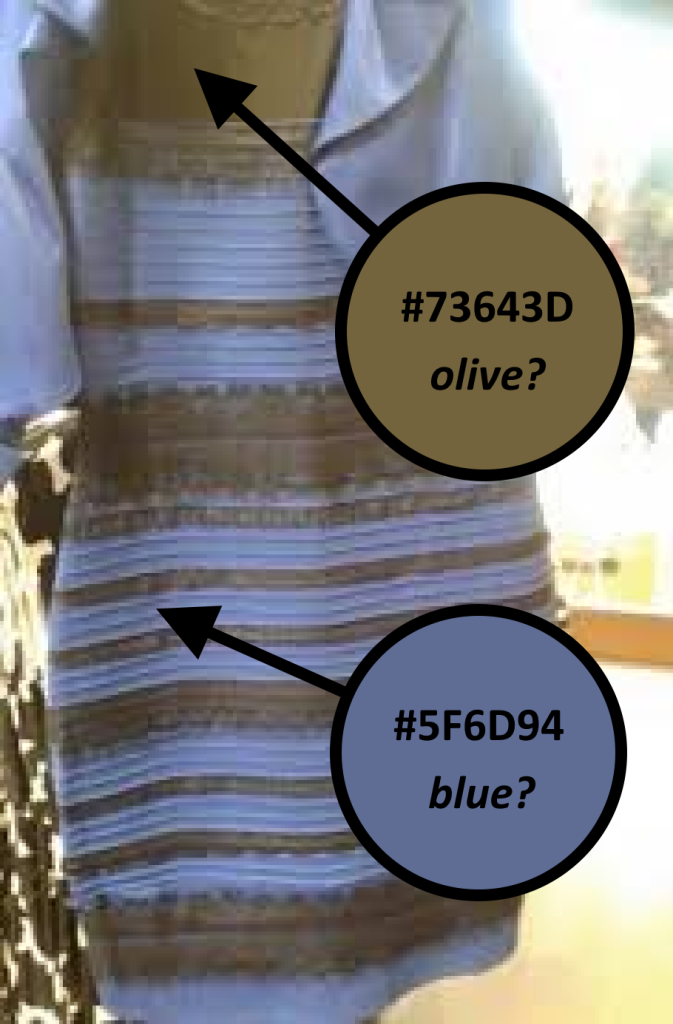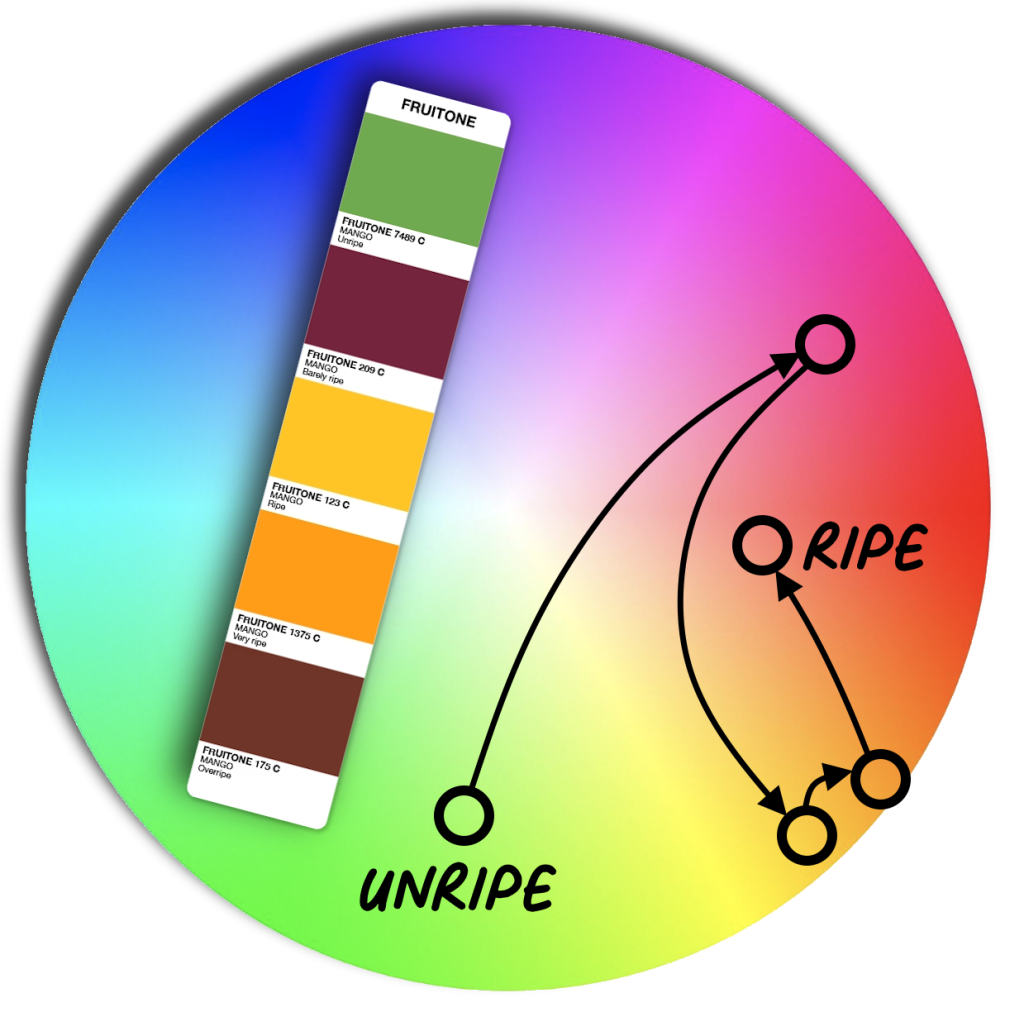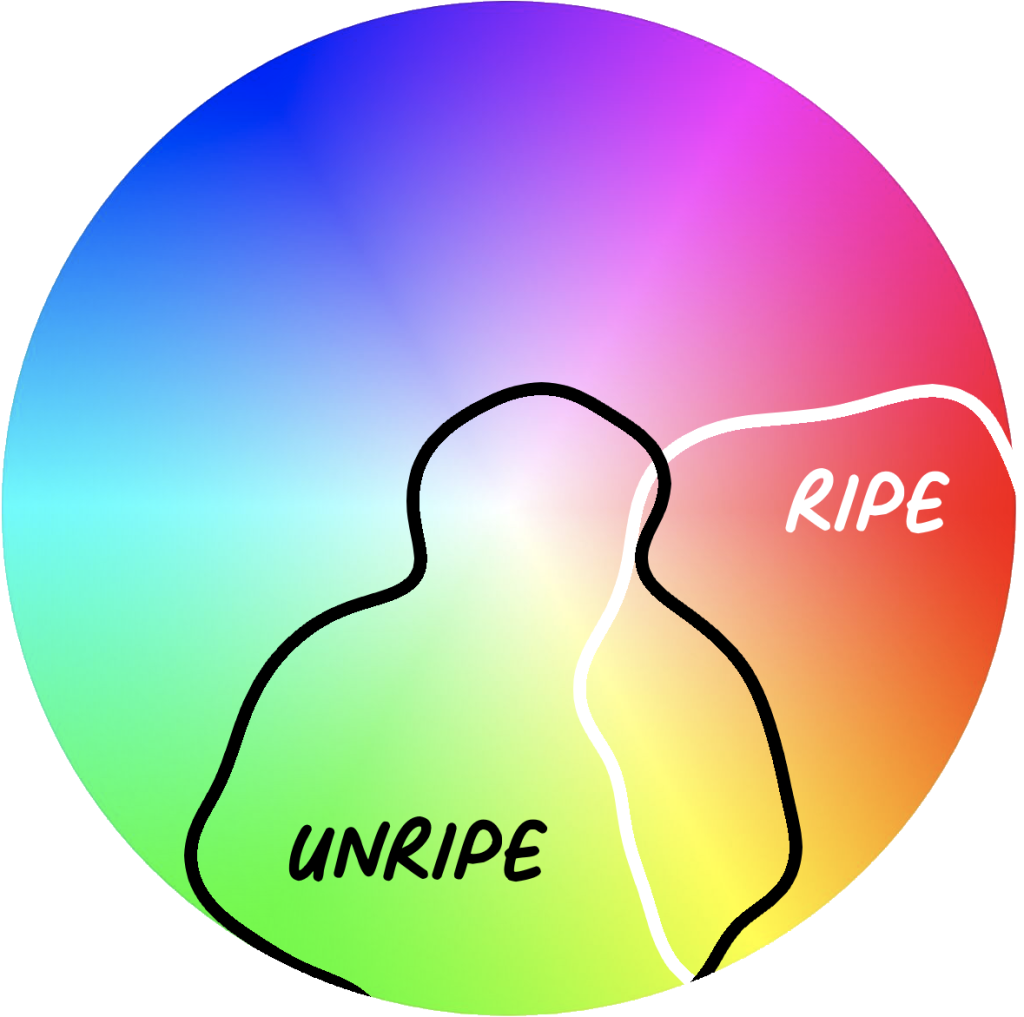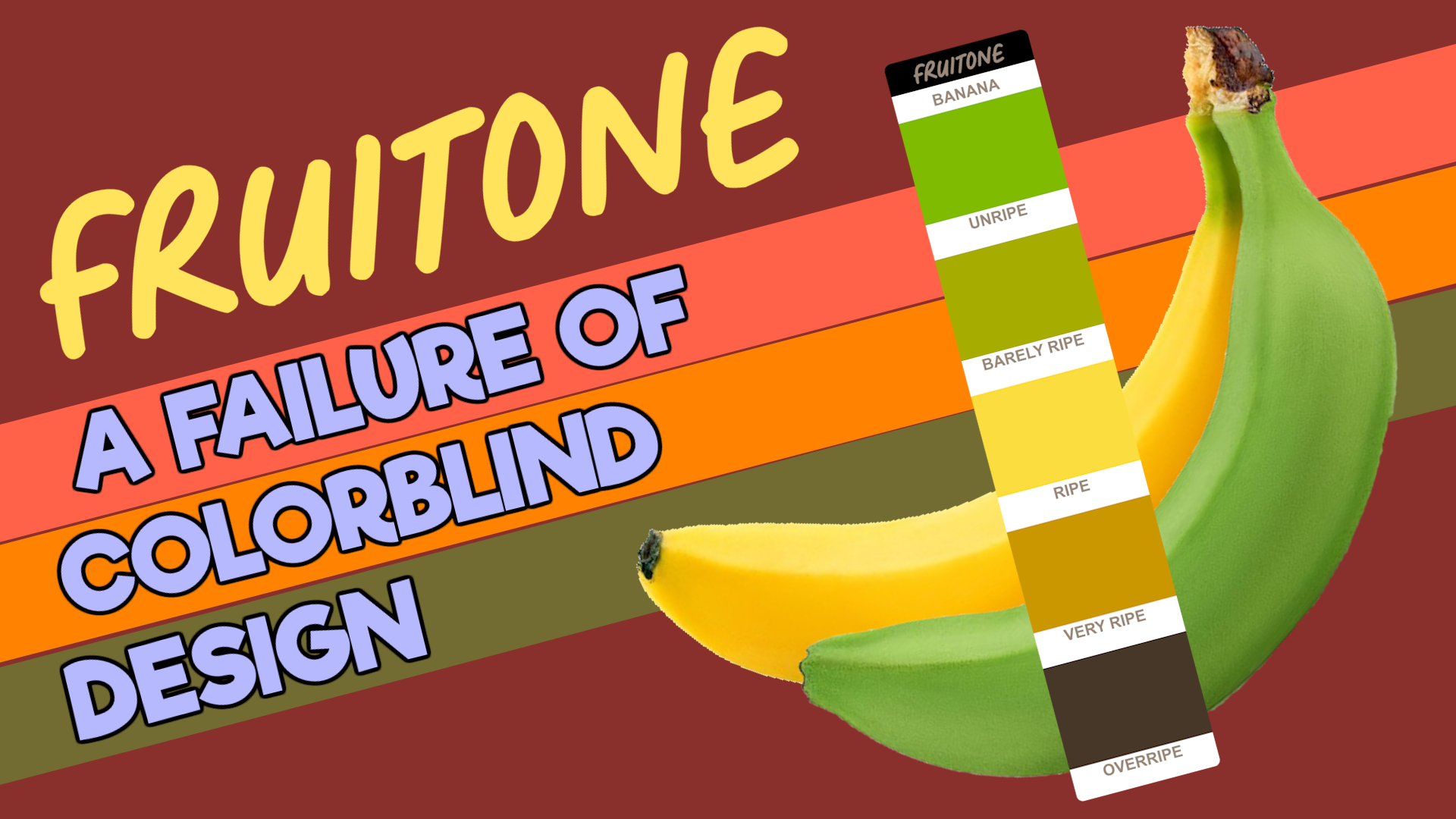Transcript + Footnotes
Judging by the number of emails I get from people with the next big color idea, everyone thinks they can help the color blind. But when you mix that helpful attitude with a complete disregard for how color blindness works or affects us, you get laughably useless tools like Fruitone. Fruitone was a prototype for a color vision aid that was intended to help us colorblind folk tell when fruit is ripe. But when I saw it, my BS detector went on full volume. Identifying ripe fruit is indeed one of the most universal hurdles experienced by the color blind. Prominently, difficulties between green and yellow bananas. For bananas (and several other fruits with color as a ripeness indicator) a tool for effectively interpreting the color could be quite helpful.
Unfortunately for us, Fruitone was no such thing. So how did it work? Fruitone was essentially a book of paint chips where each card would include the colors of a given fruit’s development from unripe to overripe. Each color was described by a Pantone color, so… now you see where the name comes from: Pantone… Fruitone… A level branding. Pantone is a proprietary list of colors with huge licensing fees that has been little more than a money printing scheme for the past half century, but I digress. The intended use of Fruitone was that you take them shopping (or foraging, or dumpster diving, no judgment). Then you compare the color of your perspective snack to the color on the color chip, ostensibly determining the ripeness in the process.
But this system completely misunderstood what color blindness is. Color blindness is not a mental illness where we can’t remember what color a ripe banana is.
Footnote 1
The concept of Fruitone posits that the colorblind are able to perform comparative color tasks (determining how different two colors are) as well as color normals, but unable to perform connotative color tasks (translating between a color and an associated meaning, i.e. green = unripe). However, any form of colorblindness that is borne in the eye (i.e. 99.99% of cases of colorblindness) will render the subject worse at comparative color tasks. A pathology that would inhibit connotative color tasks – but not the comparative color tasks required to use Fruitone – would be a mental disability, not a visual one.
Hell, even fully achromatic people – those who have never experienced color – know that bananas are yellow, even if they don’t even know what yellow really is. Norwegian achromat Knut Nordby was Oliver Sacks’ companion during the filming of Island of the Color Blind and this is what he had to say about bananas:
I think this is a sort of greenish thing, but that’s probably because I know what it is. Bananas are usually yellow. If the internals of a banana are yellow too, I wouldn’t know, but I guess it was yellowish.
Knut Nordby (1942-2005) during filming of Island of the Colorblind
So he knows that ripe bananas are yellow, because color blindness is not about being ignorant of color. Rather, color blindness is the effect of two colors that appear distinct to a color normal person to appear the same to me. Hence why banana green and banana yellow are just both banana grellow in my books and I can’t differentiate ripe from starchy. But what happens when I’m armed with a Fruitone banana card?
Watch out, world. I’m buying bananas with confidence.
The card supposes that green bananas will color match to this square, and yellow bananas will color match to this square. And this is true for color normals, and it is also true for the color blind too, but if we throw a color blind simulation on the scene, a banana at any state of ripeness will match both the green and yellow references regardless. So I’m no closer to identifying whether the banana will taste good, and I just pick up a donut instead.
And there are so many fruits that according to Fruitone, change color with ripeness: avocado, melon, kiwis. It’s just not a change I’ve ever been able to detect, as you can tell from the Fruitone cards on your right that are simulated to appear as a color blind person would see them. There are some fruits where I do see a difference in color at each stage of ripening, including passion fruit, nectarines, and tomatoes. Yeah, tomatoes… that famously turn from green to red, can be seen by lots of people with red green color blindness. Silly, right? But if I can perceive the color change, why do I need a color reference to help me tell if it’s ripe? Sure, buying some obscure fruits for the first time may benefit from the system. I have bought passionfruit exactly one time before, had no idea what to look for in terms of color and they were indeed far from ripe when I got them home. Fruitone could have helped me there, but not as much as it could have helped a color-normal person in the exact same passionfruit-buying-virgin situation. Though in that case, Fruitone is not a colorblind aid… it’s a color-normal aid.
There is a reason Fruitone never got off the ground, and it seems kind of pointless to kick them when they’re down. But I just hope that by presenting my line of reasoning here for why so many color blind aids fail right out of the gate, that these criticisms could help you devise a more effective aid. Want to learn more about color vision? Well, consider subscribing to this channel by clicking on that #0F0F0F colored button and turning it into #F2F2F2… Anyway…
Footnote 1.5 (not referenced in video)
On their website, the designers of Fruitone also described a never-released app as an alternative to the color cards. I recorded a segment on this, but turns out I was wrong about what the app was intended for. I THOUGHT the app would have essentially been a color identifier using your phone’s camera as a colorimeter. This would have solved Fruitone’s fundamental flaw, since now the evaluation of color shifts from my colorblind, dichromatic eye to a non-colorblind, trichromatic camera. However, during editing, I see that the app was only ever supposed to be a digital version of the cards. Terrible.
Let’s take a look at how Fruitone determined the color for their cards. They find some pictures online and sample the colors (hopefully perform some averaging) and then find the closest labeled Pantone color. But color is not some immutable characteristic of a fruit and will experience loads of variants independent of the state of ripeness.

- First, if it was actually meaningful to sample an object’s color from a digital image, there would have been no worldwide controversy over the color of The Dress. The color recorded in a photo is usually not a faithful representation of the color of the object. Depending heavily on what is illuminating the fruit in the photo, sampling some pixels RGB values in Photoshop as seen here will not get you a true color.
- Second, there is a lot of variance between different varieties of a given fruit. All of these mangoes are ripe, yet definitely not the same color. In fact, Fruitone’s reference mango moves from green to purple, then back to yellow, orange and red, but no mango variety does that. You can also see this with the ridiculous melon card. Like which melon? Because a watermelon and a cantaloupe are not going to follow the same color changes.
- Third, even within one variety, there’s a lot of variance in what color a ripe fruit can be. I analyzed dozens of pictures of Hayden mangoes and came back with its ripe and unripe colors covering these regions. Notice not only the large regions that count as ripe and unripe, but also the fact that they overlap. Plus, as I was scraping for pictures of mangoes tagged as ripe or unripe, I came across lots of crap like this where the ripe mango is very obviously a mirrored and color shifted version of the unripe mango (or vice versa), and the colors are therefore meaningless. Just two weeks ago I bought a sack of mandarins which were bright green. Green and orange are a common confusion pair for the red green color blind (grorange), so when I brought them home, my wife made fun of me relentlessly, as if I had just traded our cow for some magic beans. Neither of us had heard of green oranges before, but apparently it’s normal. And they were actually super delicious. In any case, they would not have been accurately identified by a Fruitone card for oranges.

Footnote 2
If you have watched my video on ColorGrab, you understand why it is necessary to have a white reference to assess the color of the lighting and accurately identify a color. Likewise, pulling colors from an image requires a white reference in the image or to make some assumptions about lighting, which is impossible to do in a cropped picture of fruit. Furthermore, for the Fruitone card to match a real fruit, the card color has to be sampled using a white reference that matches the white expected in the grocery store you’ll be shopping in. Just remember that grocery stores use different temperatures of illumination in different sections of the store to optimize the look of their food, hence why the deli will be in cool 5000K light while the bakery and produce will look better in very warm 3000K light. During dumpster diving, results will vary even more.

Suffice it to say, your color model will be crap if your input data is crap. You can’t just cherry pick your cherry colors from online pictures and create a useful tool. I’m sure they put a lot of work into Fruitone’s development, but a robust tool would need a lot more work and in the end would still be a fundamentally ineffective aid for the colorblind.
The developers of Fruitone could have avoided all of that effort if they had just started the design process by asking themselves one simple question that all inclusive designers should ask themselves:
Can I reach the same end goal, that is a judgment of ripeness by avoiding color altogether?
Many designers of color blind aids fail right from the get-go by not asking this question. They presume that since color is the most useful method for completing a task to them that being color blind renders us incapable of completing said task, but in reality they just never learned the alternative methods for judging ripeness, many of which are more effective than color. These alternative methods are seldom known simply because color-normals don’t need to use them. So how is a poor color blind kid with no color blind parents supposed to learn about them?
Well, at the zoo, naturally.
While the great apes are also trichromatic, New World monkeys, Capuchins for example, have very polymorphic vision, in that the males are always dichromatic (or color blind) while the females exhibit a broad spectrum of trichromatic vision that approximates normal human color vision. Considering capuchins eat almost nothing but wild fruit, how do the male monkeys do compared to their color-enhanced lady friends? Luckily someone has written several papers about how boy and girl monkeys handle their guavas differently, and unsurprisingly, males rely much more on scent and touch than the females, especially on fruits like guava and persimmon, where I (and my capuchin bros) see very little change in color during ripening. Not only that, but the same authors found that firmness and smell are actually more reliable indicators of the nutritional value of the fruit than is color.
In my video on how to cook meat for the color blind, I showed why aids that help the color blind judge the color of meat are ineffective since color is an indirect metric of doneness. Like ripeness, doneness means a lot of things, but the primary transformation is the neutralization of harmful pathogens like salmonella. Secondary would be the change in texture and the increase in temperature, since these are also desirable qualities in and of themselves. And tertiary would be the change of color, since that is strictly an indicator of doneness and doesn’t directly affect your enjoyment of the meat. Actually, the consensus on meat is that not even color normals should rely on color when a much more direct and precise metric of doneness is available: Temperature. Sorry vegans, back to fruit.
Taking that same framework, the primary transformation during fruit ripening is the conversion of starches to simple sugars that makes the fruit Yum. Then there are secondary transformations like softening, decreasing of tartness, and release of volatile chemicals that smell good. These are all indicators of the sugariness, but are also desirable themselves. Then (again) there is color as the tertiary change, which is used almost exclusively as an indicator since only rarely is the color itself the desirable quality.
Footnote 3
The other tertiary transformation often cited is ethylene production, but we don’t have ethylene detectors, so its not at all a useful indicator.
My mother – a color normal – taught me to smell pineapples and cantaloupes to judge ripeness – sniffing for those delicious volatile chemicals – but only because color-normals don’t detect any significant color change during ripening of those fruits. It’s therefore culturally normalized to use your nose. But I have never seen someone sniffing bananas in the greengrocers, and that’s unfortunate, because those smell changes also occur in fruits traditionally identified by color. Seriously, be brave. Go sniff some green and yellow bananas. There’s a clear difference. You may look odd sniffing up a banana in the produce aisle, but you shouldn’t let the normies shame you into struggling with color when you can manage just fine with your sniffer.
Footnote 4
Pineapples are non-climacteric fruits and – like grapes and cherries – do not ripen after they have been picked. If they are picked to early, they will progress from unripe, directly to rotten. There is a color change as they ripe, as well as as they rot. You mostly just gotta trust your pineapple supplier and EAT THE PINEAPPLE RIGHT AWAY, because like corn on the cob, its not getting any yummier the longer it sits in your house.
Or, instead, just squeeze it. Bananas actually soften quite predictably with ripeness, but this fact is often overshadowed and forgotten because of the whole green/yellow business. I find squeezing the short tip of the banana is the best place to gauge the ripeness, but it also doesn’t leave a bruise. Kiwis, pears, mangoes, I squeeze them all… and get your mind out of the gutter. If you’re worried about fruit-borne COVID or whatever, stick your hand through a plastic bag. And if you’re worried about bruising the fruit, squeeze near the stem and don’t squeeze harder than you’d squeeze your best friend’s nipple.
Look, Fruitone was never commercialized. As far as I can tell, it was just some student design project and they probably got an “A” for it because most color-normals don’t really understand how color vision works. In the end, I don’t want to be overly critical of color blindness aids and assistive tools, because they are important. But even more important is for the color blind to not be apologetic about your condition.
Embrace your inner capuchin.
Sniff that banana.
This is chromophobe.

Leave a Reply